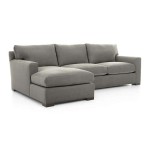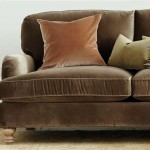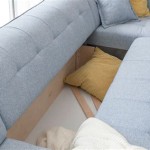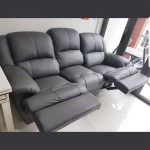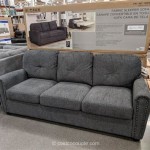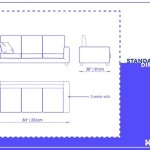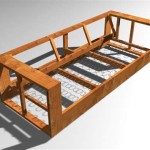The Enduring Appeal of the Mid-Century Modern Sofa
The mid-century modern sofa, a design staple from the post-World War II era to the early 1970s, continues to captivate homeowners and interior designers today. Its clean lines, organic shapes, and focus on functionality resonate with contemporary aesthetics, making it a timeless addition to any living space. The enduring popularity of this style stems from its versatility, its adaptability to different room sizes and decor styles, and its ability to blend comfort with sophisticated design. Understanding the defining characteristics, historical context, and variations of mid-century modern sofas is crucial for those seeking to incorporate this iconic piece into their homes.
The core principles of mid-century modern design are rooted in a desire for simplicity and functionality. Post-war optimism fueled a movement away from the ornate and heavy styles of previous eras. Designers embraced new materials and manufacturing techniques, prioritizing clean lines, natural forms, and a connection to the outdoors. Open floor plans became increasingly popular, and furniture was designed to complement these spaces. The mid-century modern sofa perfectly embodies these principles, offering a comfortable and stylish seating solution without overwhelming the room.
Key Characteristics of Mid-Century Modern Sofas
Several distinctive features define the mid-century modern sofa. Recognizing these elements is essential for identifying authentic pieces and appreciating the design philosophy behind them.
Clean Lines and Minimalist Form: Perhaps the most recognizable characteristic, mid-century modern sofas typically feature straight lines, geometric shapes, and a lack of excessive ornamentation. The emphasis is on simplicity and functionality, with the sofa's form following its purpose. Rounded edges and subtle curves may be incorporated, but the overall aesthetic remains clean and uncluttered. The lack of excessive detailing allows the sofa to seamlessly integrate into various interior styles, from minimalist to eclectic.
Tapered Legs: Tapered legs are another defining feature, often made of wood (such as walnut, teak, or beech) or metal. These legs provide visual lightness and lift the sofa off the floor, contributing to the open and airy feel of the mid-century modern aesthetic. The angle and length of the legs can vary, influencing the overall style of the sofa. Some legs are straight, while others are angled outwards for added stability and a more dynamic appearance. The choice of material for the legs often complements the upholstery and frame of the sofa.
Low Profile: Mid-century modern sofas generally have a lower profile compared to sofas from other periods. This lower height contributes to the overall sense of spaciousness and openness in a room. The lower back and armrests create a more relaxed and inviting feel. This design choice also reflects the mid-century modern emphasis on horizontal lines and a connection to the ground.
Emphasis on Natural Materials: The use of natural materials is a hallmark of mid-century modern design. Wood, particularly hardwoods like walnut, teak, and oak, is commonly used for the frame and legs. Upholstery materials often include natural fabrics such as wool, linen, and cotton. These materials not only contribute to the aesthetic appeal of the sofa but also provide durability and comfort. The natural textures and warm tones of these materials create a sense of warmth and sophistication.
Button Tufting and Stitching Details: While not all mid-century modern sofas feature button tufting, it is a common design element that adds visual interest and texture. Tufting can be used on the backrest, seat cushions, or both. Other stitching details, such as piping and quilting, are also frequently employed to enhance the overall design. These details, while subtle, contribute to the sofa's refined and tailored appearance.
Materials and Upholstery of Mid-Century Modern Sofas
The materials used and the choice of upholstery play a significant role in the overall look and feel of a mid-century modern sofa. Understanding the common material choices can aid in identifying authentic pieces and selecting a sofa that complements a particular interior design scheme.
Wood Frames: As mentioned previously, solid wood frames are a defining characteristic. Hardwoods like walnut, teak, and oak are favored for their durability, strength, and appealing grain patterns. These woods are often finished with a clear coat to showcase their natural beauty. The frame provides the structural foundation of the sofa, ensuring its longevity and stability.
Metal Frames: While less common than wood frames, metal frames are also found in some mid-century modern sofa designs. Steel is a popular choice for metal frames, often finished with chrome or other metallic coatings. Metal frames offer a sleek and modern aesthetic, complementing the clean lines of the sofa. They are also known for their strength and durability.
Upholstery Fabrics: The choice of upholstery fabric significantly impacts the overall style and comfort of the sofa. Common fabric choices include:
Wool: A durable and luxurious fabric, wool is known for its warmth, texture, and resistance to wear and tear. It is a popular choice for mid-century modern sofas, providing both comfort and sophistication.
Linen: A natural and breathable fabric, linen offers a relaxed and casual aesthetic. It is known for its durability and resistance to fading, making it a suitable choice for heavily used sofas.
Cotton: A versatile and affordable fabric, cotton is available in a wide range of colors and patterns. It is a comfortable and breathable option, but it may be more susceptible to staining and wear than wool or linen.
Vinyl: While not a natural material, vinyl was commonly used in mid-century modern furniture due to its durability and ease of cleaning. It offered a practical and affordable alternative to natural fabrics.
Leather: Leather sofas, particularly those upholstered in supple, full-grain leather, were also popular. Leather adds a touch of luxury and sophistication to the mid-century modern aesthetic.
Color Palette: The color palette for mid-century modern sofas typically includes a range of earthy tones, such as browns, greens, and oranges. Bold pops of color, such as mustard yellow, teal, and avocado green, are also frequently incorporated. Geometric patterns and abstract prints were popular choices for upholstery, adding visual interest and personality to the sofa.
Notable Designers and Influences
Several influential designers and furniture companies contributed to the popularity and evolution of the mid-century modern sofa. Their innovative designs and use of materials helped to shape the iconic aesthetic that continues to be celebrated today.
George Nelson: As the Director of Design for Herman Miller, George Nelson played a pivotal role in shaping the mid-century modern aesthetic. He designed numerous iconic pieces of furniture, including several notable sofas known for their clean lines and functional design.
Charles and Ray Eames: This husband-and-wife team were pioneers of mid-century modern design, known for their innovative use of materials and their focus on ergonomic design. While they are best known for their chairs, they also designed several influential sofa models.
Florence Knoll: As the head of Knoll Associates, Florence Knoll was instrumental in promoting the mid-century modern aesthetic in corporate and residential interiors. She designed a range of furniture pieces, including sofas characterized by their clean lines and sophisticated style.
Scandinavian Design: Scandinavian design, with its emphasis on simplicity, functionality, and natural materials, heavily influenced the mid-century modern movement. Danish designers like Hans Wegner and Arne Jacobsen created iconic sofa designs that are still highly sought after today.
The Bauhaus School: While predating the mid-century modern era, the Bauhaus school of design had a significant impact on the movement. The Bauhaus principles of functionalism and simplicity heavily influenced the design of mid-century modern furniture, including sofas.
The mid-century modern sofa remains a testament to the enduring power of good design. Its clean lines, focus on functionality, and use of natural materials make it a versatile and stylish addition to any home. By understanding the key characteristics, materials, and influences behind this iconic piece, individuals can appreciate its timeless appeal and confidently incorporate it into their own interior design schemes.

Refresh Your Living Room With These Gorgeous Mid Century Sofas

Hague Mid Century Sofa Reviews Crate Barrel

Mid Century Show Wood Sofa 66 West Elm
Mid Century Sofas What S Your Style Thing Dfs

Proof That Your Home Is Lacking A Mid Century Sofa

Carlo Mid Century Sofa Metal Legs 77 5 West Elm

Ferre Leather Sofa Tan Midinmod Houston Tx

Contemporary Mid Century Modern Living Room Furniture Article Leather Couches Sofa

Mid Century Danish Three Seater Sofa In Oak With Bouclé Cover By Ole Wanscher For France Son 1950s At Pamono

Petrie 86 Green Velvet Mid Century Sofa Reviews Crate Barrel

